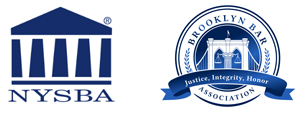Statute Of Limitations: A person has one year from the date a claim accrues to commence an action against a public authority such as LIRR (Public Authorities Law Section 1276(2). The complaint must contain an allegation that at least 30 days have elapsed since the authority was presented with a demand or claim and that the authority has neglected or refused to adjust or pay the claim. This “stay” of 30 days is not counted as part of the limitations period and the plaintiff therefore may serve a complaint at any time up to one year and 30 days after the claim has accrued.
New York
An attorney maintains a common law and statutory charging lien in the judgment
Under common law, an attorney was originally only entitled to a lien upon the judgment but the scope of the charging lien was extended by statute [Judiciary Law §475] to give the attorney a lien upon the client’s cause of action as well. The lien comes into existence, without notice or filing, upon commencement of the action or proceeding. See, Matter of Heinsheimer, 241 NY 361 [1915]. In Matter of Heinsheimer, Judge Cardozo stated,
If the attorney got possession of the fund, he had a general lien. If he did not get possession, his lien was for the services that brought the fund into existence. This charging lien still exists under our statutes. It has been enlarged to the extent that it now attaches to a cause of action even before judgment. ‘From the commencement of an action or special proceeding‘ the attorney now has a lien ‘upon his client’s cause of action, claim or counterclaim, which attaches to a verdict, report, decision, judgment or final order in his client’s favor, and the proceeds thereof in whosoever hands they may come.‘ (Judiciary Law, Cons. Laws, ch. 30, sec. 475.) Except as thus changed, the charging lien is today what it was at common law.
The concept of protecting an attorney’s lien in litigation from inception through and after entry of judgment is an old one. As stated in the decision of Fischer-Hansen v. The Brooklyn Heights Railroad Company, 173 NY 492 [1903].
There is much learning in the books relating to the lien of an attorney upon a judgment for his costs as it existed before the statute, and though now virtually obsolete, it shows the fixed determination of the courts to protect attorneys against fraudulent settlements. The lien upon a judgment was not created by statute, but was ‘a device invented by the courts for the protection of attorneys against the knavery of their clients by disabling their clients from receiving the fruits of recoveries without paying for the valuable services by which the recoveries were obtained.’ Goodrich v. McDonald, 112 NY 157 [1889].
In Peri v. The New York Central and Hudson River Railroad Company, 152 NY 521 [1897], the Court of Appeals held that an attorney’s charging lien is a statutory lien “of which all the world must take notice, and any one settling with a plaintiff without the knowledge of his attorney, does so at his own risk.” In this case, that risk is borne by all of the defendants.
New York Judiciary Law Section 475 provides:
From the commencement of an action, special or other proceeding in any court or before any state, municipal or federal department, except a department of labor, or the service of an answer containing a counterclaim, or the initiation of any means of alternative dispute resolution including, but not limited to, mediation or arbitration, or the provision of services in a settlement negotiation at any stage of the dispute, the attorney who appears for a party has a lien upon his client’s cause of action, claim or counterclaim, which attaches to a verdict, report, determination, decision, award, settlement, judgment or final order in his client’s favor, and the proceeds thereof in whatever hands they may come; and the lien cannot be affected by any settlement between the parties before or after judgment, final order or determination. The court upon the petition of the client or attorney may determine and enforce the lien.
The Court of Appeals noted, in Matter of City of New York (United States of America-Coblentz), 5 NY2d 300 [1959], that the statute gives an attorney a lien on the cause of action which attaches to the judgment from the commencement of the action. In the decision, the Court stated that Section 475, in substance, declares the common law. The origin of an attorney’s lien, whether as retaining or as charging, is obscure, but in all events, irrespective of type, has been recognized and enforced by the courts from very early times (see Fourth Annual Report of N. Y. Judicial Council, 1938, p. 49; 7 C. J. S., Attorney and Client, § 210 et seq.; 5 Am. Jur., Attorneys at Law, § 208 et seq.). The underlying purpose at both common law and now, by statute, is to protect an attorney against the ‘knavery of his client’ (Matter of Rosentover v. Weiss, 247 AD 137 affirmed 272 N.Y 557; Goodrich v. McDonald, 112 NY 157) and, being created by statute, does not require the giving of any notice in order to bring it into existence (Matter of Drake v. Pierce Butler Radiator Corp., 202 Misc. 935) for it is generally regarded as an equitable assignment to the attorney of the fund procured by his efforts to the extent of the amount of his lien (Matter of Herlihy, 274 AD 342).
Other parties do not have the ability to destroy the attorney’s vested property rights in and to the Judgment. See, LMWT Realty Corp. v. Davis Agency, Inc., 85 NY2d 462 [1995] (“Manifestly, then, an attorney’s charging lien is something more than a mere claim against either property or proceeds; an attorney’s charging lien “is a vested property right created by law and not a priority of payment”).
In enforcing the charging lien, the attorney is not required to solely chase after his client for the money he is owed; he can also pursue the other defendants. In Haser v. Haser, 271 AD2d 253 [1 Dept. 2000], the court held that, under New York law, a plaintiff’s attorney may enforce her statutory charging lien against the defendant’s own assets, if he still possesses the settlement proceeds or knowingly paid them to the plaintiff so as to deprive the attorney of her compensation (citing to Kaplan v Reuss, 113 AD2d 184, 186-187, affd 68 NY2d 693; Fischer-Hansen v Brooklyn Hgts. R. R. Co., 173 NY 492, 502). The lien which attaches in the attorney’s favor cannot be impaired by a collusive settlement.
Commercial tenants/Sublessors are responsible entities under the Labor Law
Pursuant to binding Court of Appeals precedents, as well as Appellate Division, First and Second Department precedents, commercial tenants/sublessors are responsible entities for purposes of Labor Law Section 240(1).
See Glielmi v. Toys “R” Us, Inc., 62 N.Y.2d 664, 666, 476 N.Y.S.2d 283, 284, 464 N.E.2d 981, 982 (1984) (“The jury was charged that the owner trustees and the tenant were to be considered a single unit for purposes of determining liability to the injured plaintiff. There was evidence from which the jury could properly have found that both were absolutely liable under subdivision 1 of section 240 of the Labor Law”); Godoy v. Baisley Lumber Corp., 40 A.D.3d 920, 921, 837 N.Y.S.2d 682, 683- 684 (2d Dep’t 2007); Murphy v. Sawmill Construction Corp., 17 A.D.3d 422, 424, 792 N.Y.S.2d 616, 618 (2d Dep’t 2005) (“We note that the term ‘owner,’ for purposes of Labor Law §§ 240(1) and 241(6), has been construed to include not only property owners but, under certain circumstances, also those who have an interest in property, such as easement holders and lessees (see Kane v. Coundorous, 293 A.D.2d 309, 739 N.Y.S.2d 711; Copertino v. Ward, 100 A.D.2d 565, 473 N.Y.S.2d 494).”); Bell v. Bengomo Realty, Inc., 36 A.D.3d 479, 480, 829 N.Y.S.2d 42, 44 (1st Dep’t 2007) (“Summary judgment in favor of plaintiff on the issue of liability under Labor Law Section 240 (1) should have been granted as against Bengomo Realty as the owner of the property); see Coleman v. City of New York, 91 N.Y.2d 821, 822-823, 666 N.Y.S.2d 553, 689 N.E.2d 523 [1997]; Spagnuolo v. Port Auth. of N.Y. & N.J., 8 A.D.3d 64, 778 N.Y.S.2d 23 [2004] ), and Willow Media who, as lessee, contracted for the work (see Guzman v. L.M.P. Realty Corp., 262 A.D.2d 99, 691 N.Y.S.2d 483 [1999] ).”); Meade v. Rock-McGraw, Inc., 307 A.D.2d 156, 158-159, 760 N.Y.S.2d 39, 41-42 (1st Dep’t 2003) (“After discovery, plaintiff moved for summary judgment against defendants, Rock-McGraw, Inc., the building owner, McGraw-Hill Companies, Inc., the building lessee, and Morgan Stanley & Co., Incorporated, the sublessee of the 44th floor, on his Labor Law § 240(1) claim, arguing that the ladder was not secured by another worker, that the ladder fell because the floor was slippery and the ladder lacked footings and that defendants had breached their duty to insure that the ladder was placed so as to give him proper protection. …Depending on the fact finder’s determination, plaintiff may, however, establish a section 240(1) violation for failure to provide a proper safety device.”); Kane v. Coundorous, 293 A.D.2d 309, 311, 739 N.Y.S.2d 711, 714 (1st Dep’t 2002) (“A lessee of property under construction is deemed to be an ‘owner’ for purposes of liability under Article 10 of New York’s Labor Laws (see, e.g., Glielmi v. Toys “R” Us, 62 N.Y.2d 664, 476 N.Y.S.2d 283, 464 N.E.2d 981; Bart v. Universal Pictures, 277 A.D.2d 4,5, 715 N.Y.S.2d 240; Tate v. Clancy Cullen Storage Co., 171 A.D.2d 292, 295, 575 N.Y.S.2d 832; Copertino v. Ward, 100 A.D.2d 565, 566, 473 N.Y.S.2d 494).”); Wehmeyer v. Port Authority of New York and New Jersey, 248 A.D.2d 187, 188, 669 N.Y.S.2d 578, 579 (1st Dep’t 1998).
copyr. 2014 Richard A. Klass, Esq.
The firm’s website: www.CourtStreetLaw.com
Richard A. Klass, Esq., maintains a law firm engaged in civil litigation in Brooklyn Heights, New York.
He may be reached at (718) COURT-ST or e-ml to RichKlass@courtstreetlaw.comcreate new email with any questions.
Prior results do not guarantee a similar outcome.
Klass in the News: Yoko Ono’s publicist sues Eataly for $20M after bouncer ‘beatdown’
August 29, 2014 | 11:52am
Maybe the security guards at Mario Batali‘s Eataly need to give peace a chance.
Yoko Ono‘s publicist is suing the Manhattan pasta emporium for at least $20 million after he was allegedly beaten up by bouncers, thrown through a glass window and then called a “p—–” and a “f—–.”
Kip Kouri, head of Tell All Your Friends PR, was trying to get a table at Eataly’s popular rooftop beer garden Birreria on July 17 when he was “violently assaulted by” 10 unnamed security guards, according to his Manhattan civil suit.
His attorney, Richard Klass, told The Post his client was at the Fifth Avenue eatery with his boyfriend, sister and stepmother and got into an argument with the hostess about his reservation…. opens in a new window(more)
copyr. 2014 Richard A. Klass, Esq.
The firm’s website: www.CourtStreetLaw.com
Richard A. Klass, Esq., maintains a law firm engaged in civil litigation in Brooklyn Heights, New York.
He may be reached at (718) COURT-ST or e-ml to RichKlass@courtstreetlaw.comcreate new email with any questions.
Prior results do not guarantee a similar outcome.
Repairs are a covered activity under the Labor Law
Binding precedents of the Court of Appeals, as well as the Appellate Division, First and Second Department hold that a worker assigned by his employer to perform repairs to a damaged or inoperable structure are a covered activity for purposes of the Labor Law, not merely routine maintenance. See Prats v. Port Authority of New York and New Jersey, 100 N.Y.2d 878, 880, 768 N.Y.S.2d 178, 179, 800 N.E.2d 351, 352 (2003); Riccio v. NHT Owners, LLC, 51 A.D.3d 897, 899, 858 N.Y.S.2d 363, 366 (2d Dep’t 2008); Rios v. WVF Paramount 545 Property, LLP, 36 A.D.3d 511, 828 N.Y.S.2d 368, 369 (1st Dep’t 2007); Bruce v. Fashion Square Associates, 8 A.D.3d 1053, 1054, 778 N.Y.S.2d 823, 824 (4th Dep’t 2004); Kerr v. Louisville Housing, Inc., 2 A.D.3d 924, 926, 769 N.Y.S.2d 616, 619 (3d Dep’t 2003); Craft v. Clark Trading Corp., 257 A.D.2d 886, 887, 684 N.Y.S.2d 48, 49-50 (3d Dep’t 1999); Holka v. Mt. Mercy Academy, 221 A.D.2d 949, 949, 634 N.Y.S.2d 310, 311 (4th Dep’t 1995).
“Thus, defendants suggest that a guiding principle for courts should be to examine the context of the work leading to the injury, and only when it is performed as part of a building construction job should Labor Law § 240(1) liability attach.
Such a rule would, of course, ignore prior holdings that workers injured while cleaning a railway car (Gordon v. Eastern Ry. Supply, 82 N.Y.2d 555, 606 N.Y.S.2d 127, 626 N.E.2d 912, supra ), repairing an electrical sign (Izrailev v. Ficarra Furniture, 70 N.Y.2d 813, 523 N.Y.S.2d 432, 517 N.E.2d 1318) or painting a house (Rivers v. Sauter, 26 N.Y.2d 260, 309 N.Y.S.2d 897, 258 N.E.2d 191) come within the ambit of the statute even though they were not working at a building construction site. Furthermore, we have already defined a ‘structure,’ for purposes of Labor Law § 240(1), as ‘’any production or piece of work artificially built up or composed of parts joined together in some definite manner’’ (Lewis Moors v. Contel of N.Y., 78 N.Y.2d 942, 943, 573 N.Y.S.2d 636, 578 N.E.2d 434). Now to limit the statute’s reach to work performed on a construction site would eliminate possible recovery for work performed on many structures falling within the definition of that term but found off construction sites (see, e.g., id. [telephone pole]; Gordon v. Eastern Ry. Supply, 82 N.Y.2d 555, 606 N.Y.S.2d 127, 626 N.E.2d 912, supra [railway car] ).”
“Finally, we conclude that the painting work being performed by plaintiff’s decedent was an activity covered by Labor Law § 240(1) and § 241(6). “[T]here is no requirement or condition that [painting] be incidental to the other listed activities, such as construction, repair or alteration activity, to be covered” (Chapman v. International Bus. Machs., 253 A.D.2d 123, 127, 686 N.Y.S.2d 888; see also, Bustamante v. Chase Manhattan Bank, 241 A.D.2d 327, 659 N.Y.S.2d 284). We therefore modify the order in appeal No. 1 by denying the motion of Piscitell in part and reinstating the Labor Law § 241(6) claim against it.”
“The plaintiff is also entitled to summary judgment on the cause of action pursuant to Labor Law § 241(6) and the branch of the defendant’s motion which was to dismiss that cause of action should have been denied. Contrary to the determination of the Supreme Court, the activity in which the plaintiff was engaged when he was injured falls within the scope of Labor Law § 241(6) (see 12 NYCRR 23-1.4[b][13]; Cornacchione v. Clark Concrete Co., 278 A.D.2d 800, 723 N.Y.S.2d 572; Vernieri v. Empire Realty Co., 219 A.D.2d 593, 595, 631 N.Y.S.2d 378).”
copyr. 2014 Richard A. Klass, Esq.
The firm’s website: www.CourtStreetLaw.com
Richard A. Klass, Esq., maintains a law firm engaged in civil litigation in Brooklyn Heights, New York.
He may be reached at (718) COURT-ST or e-ml to RichKlass@courtstreetlaw.comcreate new email with any questions.
Prior results do not guarantee a similar outcome.






